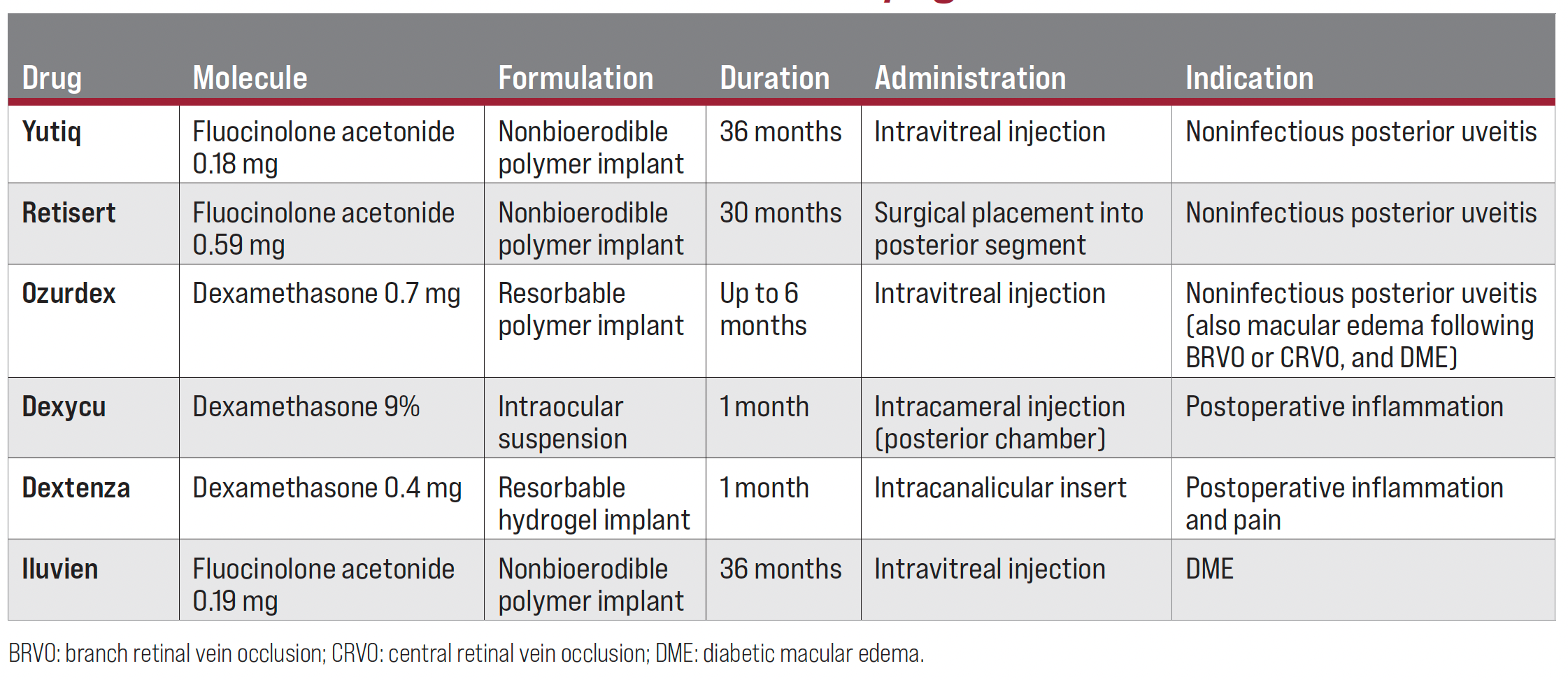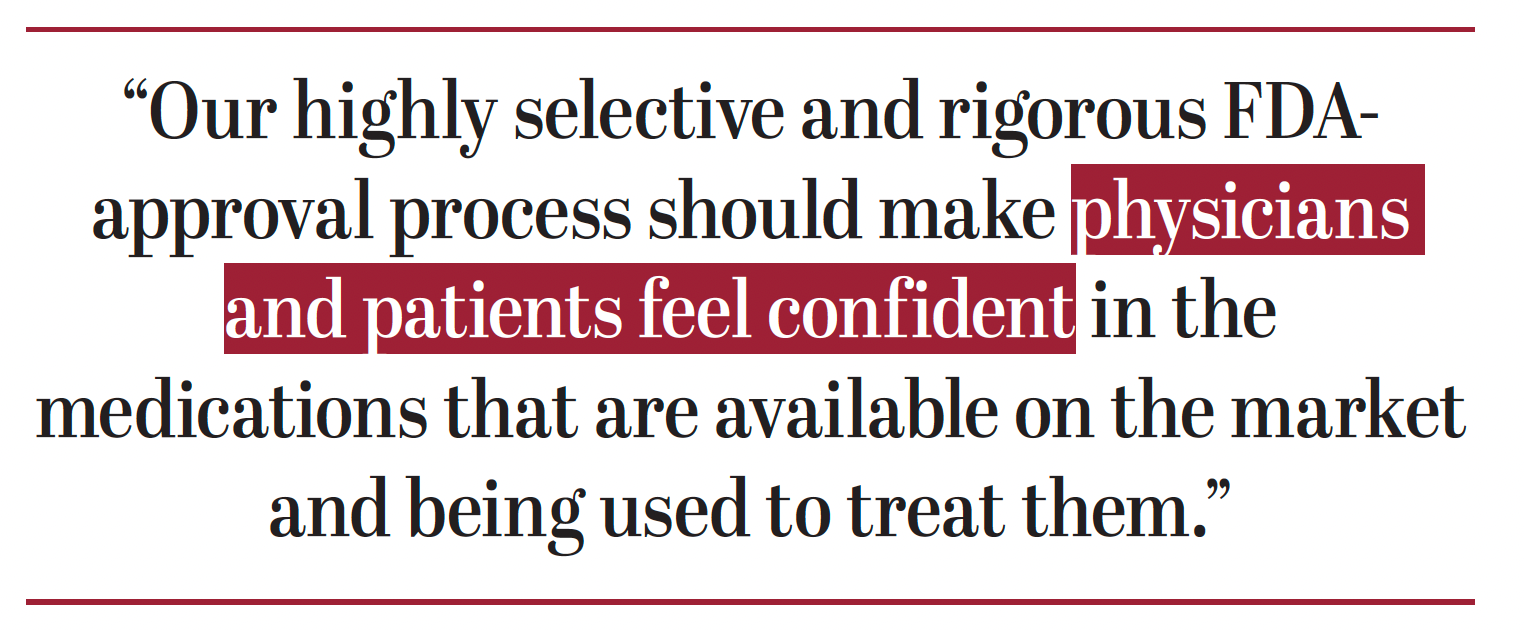Sustained drug delivery in ophthalmology
Current options, challenges in developing novel therapies.
Special to Modern Retina™

Although many chronic medical conditions affecting the eyes can be effectively managed with oral medication, most chronic ocular conditions, such as diabetic retinopathy, macular degeneration, ocular inflammation, and glaucoma, require medication to be delivered locally, usually as eye drops or injections.
Despite their apparent ease of administration, incorrect and inconsistent use of eye drops is surprisingly prevalent. More than 90% of postcataract patients self-administer their eye drops incorrectly, and about 30% of postglaucoma surgery patients are nonadherent to topical treatment.1,2
Fortunately, an increasing number of ophthalmic medications enable sustained drug delivery via intraocular or intracanalicular depots. For appropriate patients, there is significant benefit in terms of adherence, which may translate into improved efficacy and persistence with therapy. For example, in glaucoma, sustained delivery of bimatoprost via the recently-approved Durysta implant (bimatoprost implant 10 mcg, Allergan) substantially reduces the administration burden for patients while exposing target tissues to therapeutic levels of drug over several months.
Similarly, taking the example of chronic noninfectious ocular inflammation, sustained delivery of corticosteroids to the retina can offer a major advantage over conventional eye drops and frequent intra/periocular injections.
Corticosteroid implants
Table 1. Sustained-release anti-inflammatory agents.

Sustained-release steroids are available as biodegradable and nonbiodegradable implants with different active compounds and durations of effect. For short-term control of postoperative inflammation, Dextenza (dexamethasone ophthalmic insert 0.4 mg, Ocular Therapeutix) is an intracanalicular insert that releases steroid onto the ocular surface, and Dexycu (dexamethasone intraocular suspension 9%, EyePoint) is a controlled-release suspension that is injected into the posterior chamber. Both are bioerodible and designed to release dexamethasone for the first month following surgery.3
Another bioerodible formulation of dexamethasone, Ozurdex (dexamethasone 0.7 mg, Allergan), is an intravitreal implant that lasts 3 to 6 months. For some patients with uveitis and uveitic macular edema that have been unresponsive to previous treatments, Ozurdex offers greater drug release in the first 2 months, then tapers over the following few months. Patients also tend to like that it’s bioerodible.
For other patients, a more consistent, longer-term release of drug is desirable, such as that offered by Yutiq (fluocinolone acetonide intravitreal implant 0.18 mg, EyePoint) and Iluvien (fluocinolone acetonide intravitreal implant 0.19 mg, Alimera), which are indicated in the US for noninfectious uveitis affecting the posterior segment and for diabetic macular edema, respectively. Both are nonbiodegradable polymer conjugates injected intravitreally, which provide a continuous microdose of fluocinolone over about 3 years.
The Durasert sustained-release technology on which both Yutiq and Iluvien are based is also at work in Retisert (fluocinolone acetonide intravitreal implant 0.59 mg, Bausch + Lomb), which provides a higher dose of fluocinolone and must be implanted surgically, rather than as an in-office injection.
Safety considerations
A history of intraocular pressure elevation following topical steroid drops should be considered carefully when weighing the option of a sustained-release steroid implant. I tend to use shorter-acting sustained-release options (Dextenza, Dexycu) for short-term postoperative inflammation or in a patient whom I suspect may have a stronger response to steroids, which is generally a very safe way to go. If a longer extent of treatment is desired, I will generally start with a sustained-release steroid that has a shorter duration of effect first, such as Ozurdex, to make sure the patient is steroid tolerant before switching to a longer-acting implant, such as Yutiq.
Another issue to consider with intraocular implants is the potential for migration within the eye; when it occurs, it can be a problem. If the implant migrates forward from the vitreous, it can result in damage to anterior segment structures, with the potential to impact vision. Thus, intravitreal implants should be used with caution in patients who have a compromised posterior capsule or are aphakic.
Port delivery: Reducing the burden
Patients who receive regular—often monthly—anti-VEGF injections shoulder a significant burden in terms of time, expense, and invasiveness of treatment. A study from 2016 found that each injection appointment (including travel time) took an average of 4.5 hours, and 53% of working patients needed to take off at least 1 day per appointment.4 In my practice, I’ve found these injections to be especially challenging for working-age patients who are also trying to balance jobs, family obligations, and other health problems.
One approach to reduce this burden is the port delivery system (PDS), which entails a surgically placed, permanent, and refillable drug-releasing port. The ranibizumab PDS (Susvimo, Genentech) requires refills approximately every 15 months and has been FDA approved for wet age-related macular degeneration (AMD), and is in development for treatment of diabetic retinopathy and diabetic macular edema.
Developing a successful sustained-release ophthalmic drug: Challenge accepted
Challenges with developing sustained-release drugs for the eye often amount to issues with safety—the reason many products ultimately fall off the path to approval. The general principle of local, sustained delivery to ocular tissues is sound; but often, in the case of intravitreal therapies, adverse events, such as inflammation, intraocular pressure increase, and corneal issues due to implant migration are where these drugs fail. Moreover, in many cases, efficacy of investigational sustained-release drugs is adequate, but noninferiority or superiority to existing formulations is difficult to demonstrate.
There is no doubt that local, sustained delivery works, particularly in the posterior segment. With the agents available to us today, our threshold for efficacy and safety of new alternatives is higher than it may have been 15 years ago. The recent example of abicipar is illustrative: 2-year results from a pair of phase 3 studies (CEDAR and SEQUOIA) indicated that abicipar, a DARPin anti-VEGF agent, was noninferior for achieving stable vision in people with wet AMD, with fewer injections when compared with ranibizumab.
However, the trials also showed abicipar had more clinically significant medication-related ocular adverse events when compared with ranibizumab.5 Ultimately, the FDA deemed the benefit-risk ratio with abicipar unfavorable.
Clinical trial process: Rigorous and necessary

A few late-stage clinical trials are currently exploring other novel techniques to prolong duration of efficacy of intravitreal injections. KSI-301 is an anti-VEGF monoclonal antibody conjugated with a large biopolymer.
In the phase 1 study, 55% of patients achieved a 6-month retreatment interval; top-line results from phase 3 trials for neovascular AMD, diabetic macular edema, and retinal vein occlusion are expected to begin reading out in late 2021.6-8 GB-102 uses bioabsorbable microparticles to encapsulate sunitinib malate, a tyrosine kinase inhibitor that targets both VEGF-A and platelet-derived growth factor.9 This formulation may extend the intravitreal retreatment interval to 6 months, and a phase 2 trial in patients with neovascular AMD is underway.10
However, one needs to keep in mind that despite promising early-phase results, several sustained-release agents have not fared as well in late-stage trials.11,12 When it comes to developing new ophthalmic drugs and devices, we must keep in mind that not everything can be tolerated inside the eye.
As much as I want my patients to have access to more treatment options—particularly those that work over months and even years—we know in advance that a lot of these drugs won’t make it to market, and I believe this fact confirms we are running clinical trials very well. Our highly selective and rigorous FDA-approval process should make physicians and patients feel confident in the medications that are available on the market and being used to treat them.
I am glad there are partnerships that bring physicians, research groups, and pharma together, working hard to bring new and better treatment options to patients, investigating drugs and their adverse events thoroughly before the public has access to them. Patients with chronic medical conditions deserve to have treatment options that are both effective and convenient to use long-term.
Ashvini Reddy, MD
P: (210) 780-7595
Dr. Reddy has no financial disclosures related to this content.
--
References
1. An JA, Kasner O, Samek DA, et al. Evaluation of eyedrop administration by inexperienced patients after cataract surgery. J Cataract Refract Surg. 2014;40(11):1857-1861. doi:10.1016/j.jcrs.2014.02.037
2. Okeke CO, Quigley HA, Jampel HD, et al. Adherence with topical glaucoma medication monitored electronically the Travatan Dosing Aid study. Ophthalmology. 2009;116(2):191-199. doi:10.1016/j.ophtha.2008.09.004
3. Tyson SL, Bafna S, Gira JP, et al. Multicenter randomized phase 3 study of a sustained-release intracanalicular dexamethasone insert for treatment of ocular inflammation and pain after cataract surgery. J Cataract and Refract Surg. 2019;45(2):204-212. Published correction appears in J Cataract and Refract Surg. 2019;45(6):895.
4. Sivaprasad S, Oyetunde S. Impact of injection therapy on retinal patients with diabetic macular edema or retinal vein occlusion. Clin Ophthalmol. 2016;10:939-946. doi:10.2147/OPTH.S100168
5. Khurana RN, Kunimoto D, Yoon YH, et al. Two-year results of the phase 3 randomized controlled study of abicipar in neovascular age-related macular degeneration. Ophthalmology. 2021;128(7):1027-1038. doi:10.1016/j.ophtha.2020.11.017
6. Do DV. Extended durability in exudative retinal diseases using the novel intravitreal anti-VEGF antibody biopolymer conjugate KSI-301. Presented at: Angiogenesis, Exudation, and DegenerationMeeting; February8, 2020; Miami, FL.
7. A study to evaluate the efficacy, durability, and safety of KSI-301 compared to aflibercept in patients with macular edema due to retinal vein occlusion (RVO) (BEACON). ClinicalTrials.gov. Updated August 23, 2021. Accessed October 7, 2021. https://clinicaltrials.gov/ct2/show/NCT04592419?term=KSI-301&draw=2
8. A study to evaluate the efficacy and safety of KSI-301, an anti-VEGF antibody biopolymer conjugate, versus aflibercept in patients with neovascular (Wet) age-related macular degeneration (DAZZLE). ClinicalTrials.gov. Updated November 19, 2020. Accessed October 7, 2021. https://clinicaltrials.gov/ct2/show/NCT04049266?term=KSI-301&draw=2&rank=5
9. Baker-Schena L. Drug delivery for the posterior segment. American Academy of Ophthalmology. Accessed June 14, 2021. https://www.aao.org/eyenet/article/drug-delivery-for-the-posterior-segment
10. Samanta A, Aziz AA, Jhingan M, et al. Emerging therapies in nonexudative age-related macular degeneration in 2020. Asia-Pac J Ophthalmol (Phila). 2021;10(4):408-416. doi:10.1097/APO.0000000000000355
11. Allergan, an AbbVie company, and molecular partners receive complete response letter from FDA on biologics license application for Abicipar pegol. News release. AbbVie; June 26, 2020. Accessed October 7. 2021. https://www.prnewswire.com/news-releases/allergan-an-abbvie-company-and-molecular-partners-receive-complete-response-letter-from-fda-on-biologics-license-application-for-abicipar-pegol-301084188.html
12. Vantipalli S, Sall KN, Stein E, et al. Evaluation of the safety and efficacy of OTX-TP, an intracanalicular travoprost insert, for the treatment of patients with open-angle glaucoma or ocular hypertension: a phase 3 study. Invest Ophthamol Vis Sci. 2020;61(7):3488.

Newsletter
Keep your retina practice on the forefront—subscribe for expert analysis and emerging trends in retinal disease management.